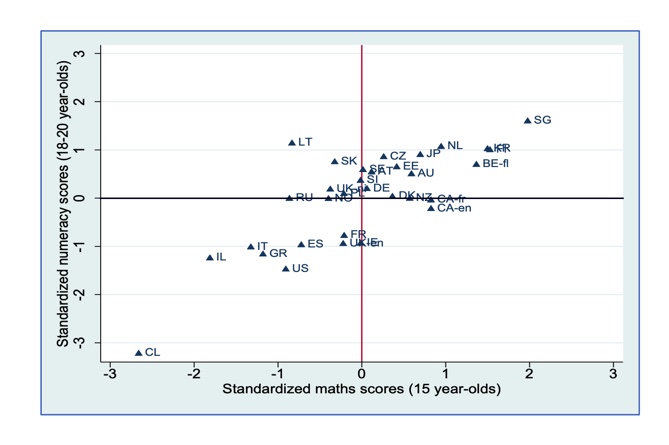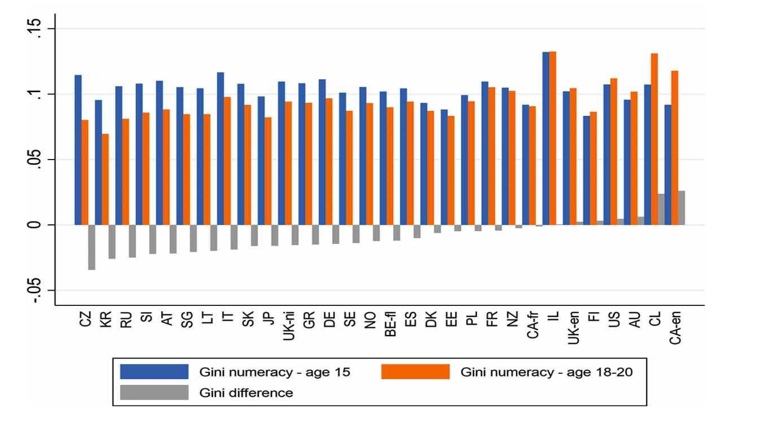Andy Green and Neil Kaye
If nothing else, Sunak’s recently announced plan for all students in England to study maths to
age 18 generated a rich crop of maths related puns in the media. Our analysis shows the plan
should be welcomed, at least in principle, as a long-overdue reform – but also how
implementing such a policy without the requisite strategic and financial backing would likely
lead to wider skills gaps and a worsening of the inequalities already seen amongst young people
leaving upper secondary education.
England is amongst a small minority of OECD countries which do not require the study of
either maths or the national language throughout upper secondary education (ages 16-18) (the
others being Australia, New Zealand, Ireland and the other nations in the UK). Furthermore,
less than half of students in post-16 education study maths as a discreet subject, many of them
instead on courses to re-take GCSE maths, in which only a meagre 20 per cent passed at grade
4 or above in 2022. It is no coincidence that literacy and numeracy levels amongst young adults
(age 16-24) in England rank poorly in international surveys of literacy and numeracy skills.
For instance, in the first round of the OECD Survey of Adult Skills (SAS), mean scores for
numeracy were lower amongst 16–24-year-olds in England than in all 22 other countries
included in the survey, bar Italy, Spain and the US. Given the importance of mathematical
competence for undertaking everyday tasks at work and in life generally in our data-rich world,
many school-leavers become particularly disadvantaged by their lack numeracy.
There will certainly be challenges in implementing Sunak’s plans for mandatory maths, as
many critics have been quick to point out. The greatest of these is the shortage of specialist
maths teachers. This would indeed be a major obstacle, particularly in further education
colleges, which cater for the majority of students who lack a good GCSE in maths, and where
maths and numeracy are often taught by non-specialists. The problem is long-standing and
requires a general re-consideration of the pay and working conditions necessary to make
teaching a more attractive profession to graduates.
Critics of the proposal also question whether there is any evidence that compulsory maths
classes would raise numeracy standards. Labour has criticised Sunak’s proposal as a ‘empty
pledge’, with shadow education secretary, Bridgit Phillipson, responding that the ‘prime
minister needs to show his working.’ Kit Yates, director of the Centre for Mathematical
Biology at the University of Bath, writes in the Guardian that compulsion may not be the best
way to encourage more students to study maths and doubts that we have hard evidence that the
policy would work. Such comments beg the question of why students in England should be
considered so uniquely incapable of learning – and benefitting – from maths tuition at upper
secondary level, when their peers in almost all other OECD countries do so, at the same time
scoring better on international surveys of numeracy skills.
In fact, there is substantial research evidence to suggest that compulsory maths to age 18 not
only correlates with higher numeracy levels amongst young adults across countries, but also
contributes to mitigating skills inequalities inherited from lower secondary education (ages 11-
16). Our recent research, for instance, shows that during the upper secondary stage there is a
significant improvement in numeracy skills, as well as reductions in numeracy and literacy
skills inequality, associated with systems where maths (and national language) are compulsory
for students up to the end of upper secondary education (e.g. South Korea, the Czech Republic
and Slovenia).
We drew upon OECD survey data from across more than 30 countries and used a quasi-cohort
approach to compare relative outcomes and distributions of core skills amongst 15-year-olds
(using PISA data) and matched cohorts of young people aged 18 to 20 (using Survey of Adult
Skills data). We then assessed the effect of a wide range of education system characteristics on
the levels and inequalities in reading/literacy and maths/numeracy between countries.
Figure 1 shows a strong correlation between average maths scores at age 15 and numeracy
outcomes amongst 18-to-20-year-olds. England (UK-en) is placed in the lower left-hand
quadrant, whereby maths scores are below-average in comparison to other countries already
by age 15 and remain so following completion of upper secondary education.

Figure 2 looks more specifically at what happens to skills distributions in maths/numeracy (as
measured using the Gini index) over the upper secondary educational stage. Whilst the majority
of countries included in our analysis are able to close the gap in numeracy during this stage (in
some case, quite considerably, e.g., the Czech Republic (CZ) and South Korea (KR)), there is
almost no change in the distribution of skills in this area in England, similar to other anglophone
countries – Australia (AU), New Zealand (NZ) and the US.

Beyond looking at cross-national trends in skills levels and inequalities, our research examined
how a range of education system characteristics – e.g. curriculum standardisation, ‘parity of
esteem’ between academic and vocational tracks, and teachers’ workload and resources – are combined at upper secondary level, to go some way towards explaining why certain types of
system are more effective in reducing skills gaps than others during this phase. We found that
relatively integrated systems with a substantial degree of standardisation around the length of
programmes and curricula across different programmes (academic and vocational), including
with the mandatory learning of maths and the national language, had significant effects in
raising numeracy levels and reducing numeracy inequality
These findings reinforce those of an earlier study by Green and Pensiero (2018), which found that having compulsory maths and the national language study throughout upper secondary systems was associated with significant improvements in country rankings in skills between age 15 and 27, with rank positions rising by 1.5 places in numeracy (p<.05) and 1.8 (p<0.1) places in literacy. The proportion of students in upper secondary education studying maths (with data taken from Hodgen et al, 2010) also had a significantly effects (P<0.1), increasing country rank positions by 0.64 in literacy and 0.69 in numeracy.
On this basis, we argue that upper secondary education systems might be able to counteract
skills gaps by implementing greater curriculum standardisation across programmes in key areas
relating to core skills learning – especially if that spans academic and vocational programmes.
Nonetheless, we also found that high teacher workloads were also associated with increasing
inequalities in core skills, lending further emphasis to the necessity to recruit and retain greater
numbers of teaching staff if post-16 compulsory maths is to be achievable to any meaningful
degree, and to the benefit of all learners.

